BORDOFLOW
Agroblend BORDOFLOW NEW Home Fungicide Product Information on the product BORDOFLOW NEW is a liquid suspension fungicide based on a Bordeaux mixture paste, with preventive action and notable effectiveness and persistence. The high degree of copper particle micronization ensures homogeneous and uniform coverage of the treated vegetation even at lower doses.The fluid paste formulation guarantees excellent adhesion and high resistance to wash-off, combined with practical dosing and operator safety. Please consult the technical service for advice on specific crops and conditions. Contact Now >> HAZARD STATEMENTS:– Very toxic to aquatic organisms, with long-lasting effects.– To avoid risks to human health and the environment, follow the instructions for use. PRECAUTIONARY ADVICE:– Wear protective gloves and clothing. Collect any spilled material.– Dispose of the product/container in accordance with national regulations. ADDITIONAL INFORMATION:– Do not contaminate water with the product or its container.– Do not clean application equipment near surface waters.– Avoid contamination through farm drainage systems and roads. To protect aquatic organisms, maintain an untreated safety zone from surface water bodies of:– 5 meters when using sprayers that reduce drift by 75%, or 20 meters for late applications on kiwifruit and fruit trees;– 5 meters for early applications on vineyards, fruiting vegetables, potatoes, leafy vegetables, bulb or root vegetables, legumes, flowers, and ornamentals;– 10 meters when using sprayers that reduce drift by 75%, or 20 meters for applications on olive trees and citrus crops;– 20 meters when using sprayers that reduce drift by 75% for applications on ornamental plants and fruit with peel (early applications). INFORMATION FOR THE MEDICSymptoms: protein denaturation with mucosal lesions; liver, kidney, and central nervous system damage; hemolysis.Vomiting with green material, gastroesophageal burning, bloody diarrhea, abdominal pain, hemolytic jaundice, liver and kidney failure, convulsions, collapse. Fever caused by metal inhalation. Irritant to skin and eyes. TREATMENT: gastric lavage with lacto-albumin solution; if copper levels are high, use chelating agents — penicillamine if oral administration is possible, or CaEDTA intravenously and BAL intramuscularly; otherwise, provide symptomatic treatment.Warning: Consult the Poison Control Center. Information Additional Information Preparation of the Mixture:Dissolve the recommended dose directly in water. If low-volume sprayers are used, the prescribed doses should be maintained to ensure the same amount of product is distributed per unit area. Resistance Management:Manamid 100 SC contains Cyazofamid, a substance from the FRAC Group 21. To avoid the development of resistance, follow these measures: Apply the product preventively. Combine it with products targeting the same pathogen but with a different mode of action. Use it in a program with other products that have different modes of action. Pre-Harvest Interval (PHI):– Tomatoes (greenhouses and open field): 3 days– Potatoes: 7 days– Grapes: 21 days Storage and Handling:Store in original containers, tightly sealed, in dry and well-ventilated areas, away from direct sunlight. Avoid using high water pressure (risk of contamination). Information Usage & Dosage Grapes: For controlling downy mildew (Plasmopara viticola), apply at a dose of 0.9-1.1 L/ha (water volume 300-1000L). Apply before flowering to ripening, stages: BBCH 11-89. Up to 4 treatments per season can be applied at 8-10 day intervals (12-14 days if the maximum dose is used). Do not apply during flowering. Tomatoes (in greenhouses and open fields): For controlling downy mildew (Phytophthora infestans), apply at a dose of 0.8 L/ha (water volume 400-1000L). Apply before flowering to ripening, stages: BBCH 12-89. Up to 6 treatments per season can be applied at 7-10 day intervals. Potatoes: For controlling downy mildew (Phytophthora infestans), apply at a dose of 0.8 L/ha (water volume 200-500L) or 80 ml/100L of water (0.8 L/ha). Apply during leaf development up to pre-harvest, stages: BBCH 12-89. Up to 6 treatments per season can be applied at 5-7 day intervals (10 days if the risk is low). Information Compatibility The product has been tested and is compatible with the following: Fungicides:– Azoxystrobin– Benalaxyl M– Cimoxanil– Dimethomorph– Folpet– Fosetyl aluminum– Disodium phosphonate– Potassium phosphonate– Mancozeb– Metalaxyl-M– Metiram– Penconazole– Copper– Sulfur Insecticides:– Abamectin– Deltamethrin– Imidacloprid– Lambda-cyhalothrin Information Active Ingredients Active Ingredients 10% metallic copper (in the form of Bordeaux paste) Information Usage & Dosage Crop Diseases Time of Application Dosage (ml/hl) Dosage/ha (L) Max. N° of treatments per season Interval between treatments (days) Pome Fruit(Apple, Pear, Quince, etc.) Scab (Venturia inaequalis), Branch Canker (Nectria galligena), Bacteriosis From end of flowering until pre-harvest 200-500 2.0-5.0 6 15 From end of harvest until flower bud opening 800-1200 8.0-12.0 4 Stone Fruit(Peach, Apricot, Nectarine, Cherry, Plum) Leaf Curl (Taphrina deformans), Shot-hole (Coryneum sp.) From end of harvest until bud opening. 800-1200 8.0-12.0 4 15 Only Peach, Nectarine, Apricot for post-flowering treatments Bacteriosis Post-flowering until harvest 200-300 2.0-3.0 6 7 VINE Downy Mildew (Plasmopara viticola) Post-flowering until harvest 300-800 3.0-8.0 8 7 OLIVE Peacock Spot (Spilocaea oleagina) Treatments from late winter until the start of ripening, as well as after harvest 750-1000 7.5-10.0 4 20 Artichoke Downy Mildew (Bremia spp.) When conditions favorable for the disease are verified 500-750 4.0-6.0 4 7 ASPARAGUS Stemphylium (Stemphylium vesicarium) Intervene after spears have been harvested. 400-750 3.2-6.0 4 12 CITRUS(Orange, Lemon, Mandarin, etc.) Gummosis (Phytophtora citricola) Treatments starting from the end of winter 800-1000 8.0-10.0 4 8 Kiwi Bacteriosis (Pseudomonas spp.) Treatments with leaf fall and winter treatments 800-1000 8.0-10.0 4 15 Walnut, Hazelnut, other shell fruit Bacteriosis (Xanthomonas spp. arboricola pv. corylina.) Post-flowering until harvest 300-400 3.0-4.0 8 10 Lettuce, various leafy vegetables in open field and greenhouse Downy Mildew (Bremia lactucae), Alternaria (Alternaria spp.), Bacteriosis Autumn-winter treatments 800-1000 8.0-10.0 4 7-8 Cabbage(Cabbage, Broccoli, Cauliflower) Downy Mildew (Phytophthora brassicae), Alternaria (Alternaria brassicae) When conditions favorable for the disease are verified 400-750 3.2-6.0 6 7 CUCURBITS(Cucumber, Pumpkin, Watermelon, Melon, etc.) in open field and greenhouse Downy Mildew (Pseudoperonospora cubensis) When conditions favorable for the disease are verified 500-750 4.0-6.0 4 7 Tomato, Eggplantin open field and greenhouse Phytophthora (Phytophtora spp.), Alternaria (Alternaria porri), Bacteriosis (Xanthomonas spp., Pseudomonas spp.) When conditions favorable for the disease are verified 400-750 3.2-6.0 6 7 POTATO Late Blight (Phytophtora infestans), Alternaria (Alternaria spp.) When conditions favorable for the disease are verified 500-750 4.0-6.0
MANAMID 100 SC
Agroblend Manamid 100 sc Home Fungicide Product Information on the product Fungicide for controlling diseases and pests in potatoes, tomatoes, and grapes. MANAMID® 100 SC is a preventive fungicide used against Plasmopara viticola and Phytophthora infestans on grapes, tomatoes, and potatoes. It has a very high affinity for the cuticular wax, with a moderate penetration capacity. This results in resistance to wash-off by rain and partial redistribution within the treated vegetation. Adjust the treatment frequency according to weather trends and disease pressure. Please consult the technical service for advice on specific crops and conditions. Contact Now >> EUH 401: To avoid risks to human health and the environment, follow the instructions for use. EUH 208: Contains 1,2-benzisothiazolin-3-one. May cause an allergic reaction. H410: Very toxic to aquatic life with long-lasting effects. P102: Keep out of reach of children. P270: Do not eat, drink, or smoke when using this product. P273: Avoid release to the environment. P391: Collect spillage. P333+P313: If skin irritation or damage occurs, call a doctor. P401: Keep away from food and feed. P501: Dispose of contents/container in accordance with local/regional/national/international regulations. First Aid Instructions: In case of poisoning, contact a doctor for immediate standard medical assistance. Information Additional Information Preparation of the Mixture:Dissolve the recommended dose directly in water. If low-volume sprayers are used, the prescribed doses should be maintained to ensure the same amount of product is distributed per unit area. Resistance Management:Manamid 100 SC contains Cyazofamid, a substance from the FRAC Group 21. To avoid the development of resistance, follow these measures: Apply the product preventively. Combine it with products targeting the same pathogen but with a different mode of action. Use it in a program with other products that have different modes of action. Pre-Harvest Interval (PHI):– Tomatoes (greenhouses and open field): 3 days– Potatoes: 7 days– Grapes: 21 days Storage and Handling:Store in original containers, tightly sealed, in dry and well-ventilated areas, away from direct sunlight. Avoid using high water pressure (risk of contamination). Information Usage & Dosage Grapes: For controlling downy mildew (Plasmopara viticola), apply at a dose of 0.9-1.1 L/ha (water volume 300-1000L). Apply before flowering to ripening, stages: BBCH 11-89. Up to 4 treatments per season can be applied at 8-10 day intervals (12-14 days if the maximum dose is used). Do not apply during flowering. Tomatoes (in greenhouses and open fields): For controlling downy mildew (Phytophthora infestans), apply at a dose of 0.8 L/ha (water volume 400-1000L). Apply before flowering to ripening, stages: BBCH 12-89. Up to 6 treatments per season can be applied at 7-10 day intervals. Potatoes: For controlling downy mildew (Phytophthora infestans), apply at a dose of 0.8 L/ha (water volume 200-500L) or 80 ml/100L of water (0.8 L/ha). Apply during leaf development up to pre-harvest, stages: BBCH 12-89. Up to 6 treatments per season can be applied at 5-7 day intervals (10 days if the risk is low). Information Compatibility The product has been tested and is compatible with the following: Fungicides:– Azoxystrobin– Benalaxyl M– Cimoxanil– Dimethomorph– Folpet– Fosetyl aluminum– Disodium phosphonate– Potassium phosphonate– Mancozeb– Metalaxyl-M– Metiram– Penconazole– Copper– Sulfur Insecticides:– Abamectin– Deltamethrin– Imidacloprid– Lambda-cyhalothrin Agroblend Check out our product catalog! For a list of all the products & information on their usage. Click here to view >> Tap here to view >> Agroblend Other Products Blackfield Terraflex Final 4-8-36+3MgO+TE Belmonda Romanov
BOTREFIN PLUS
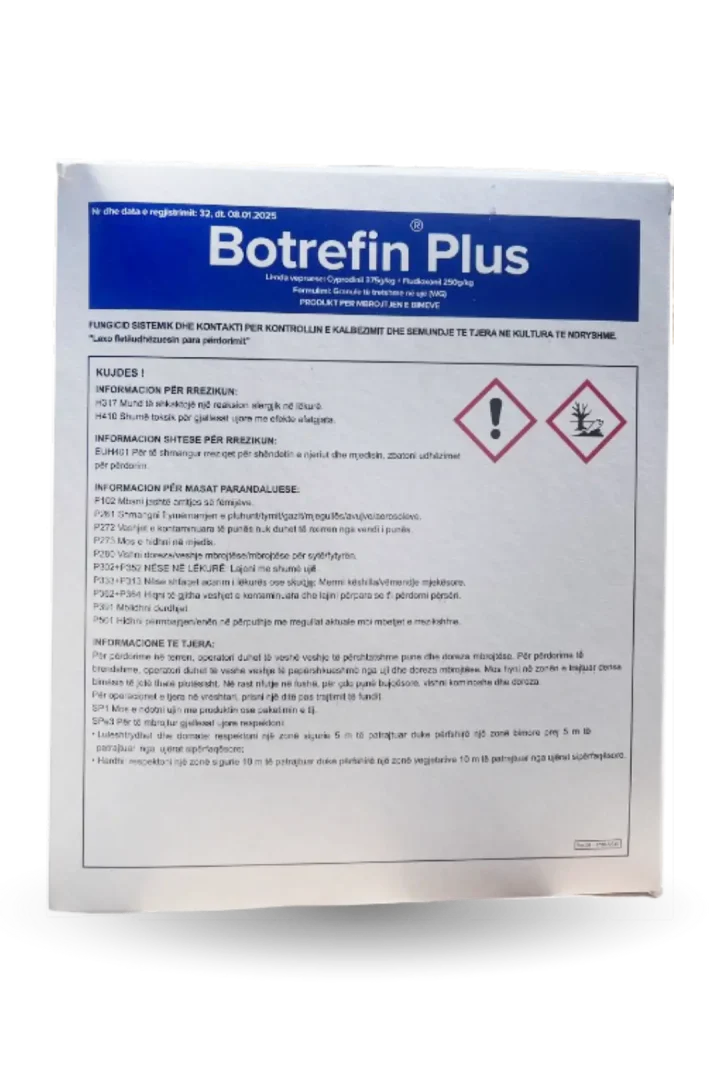
Agroblend BOTREFIN PLUS Home Organic Protection Product Information on the product Systemic fungicide for the control of rot and other diseases in various crops. BOTREFIN® Plus is a fungicide in the form of water-soluble granules used to control grey mold (rot) in grapes, strawberries, and tomatoes. It consists of a combination of two different active ingredients, Cyprodinil and Fludioxonil, and has both partially systemic and contact activity. It also features a mode of action distinct from that of benzimidazoles, dicarboximides, and sterol biosynthesis inhibitors. Please consult the technical service for advice on specific crops and conditions. Contact Now >> Agroblend Check out our product catalog! For a list of all the products & information on their usage. Click here to view >> Tap here to view >> Agroblend Other Products Dantesco Ammonium Nitrate 34.4% Nitrogen Eurogold Saletty
PORTER 250 EC
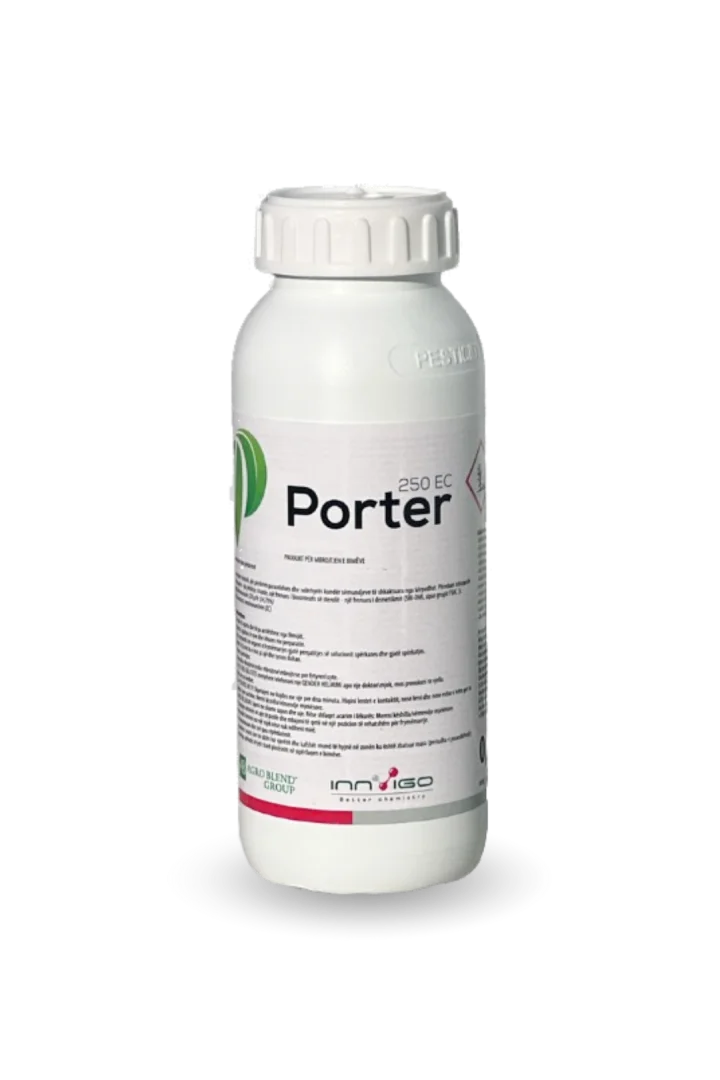
Agroblend PORTER 250 EC Home Organic Protection Product Information on the product Systemic action fungicide, for preventive and curative use against diseases caused by fungi. Active ingredient: Difenoconazole 250 g/l (24.78%)Formulation: Emulsifiable concentrate (EC) Usage: Potatoes, apples, cereals Please consult the technical service for advice on specific crops and conditions. Contact Now >> Agroblend Check out our product catalog! For a list of all the products & information on their usage. Click here to view >> Tap here to view >> Agroblend Other Products Donatelo Master Gold NPK 20.20.20+TE Elite Fontelis
ELEMA 500 SC
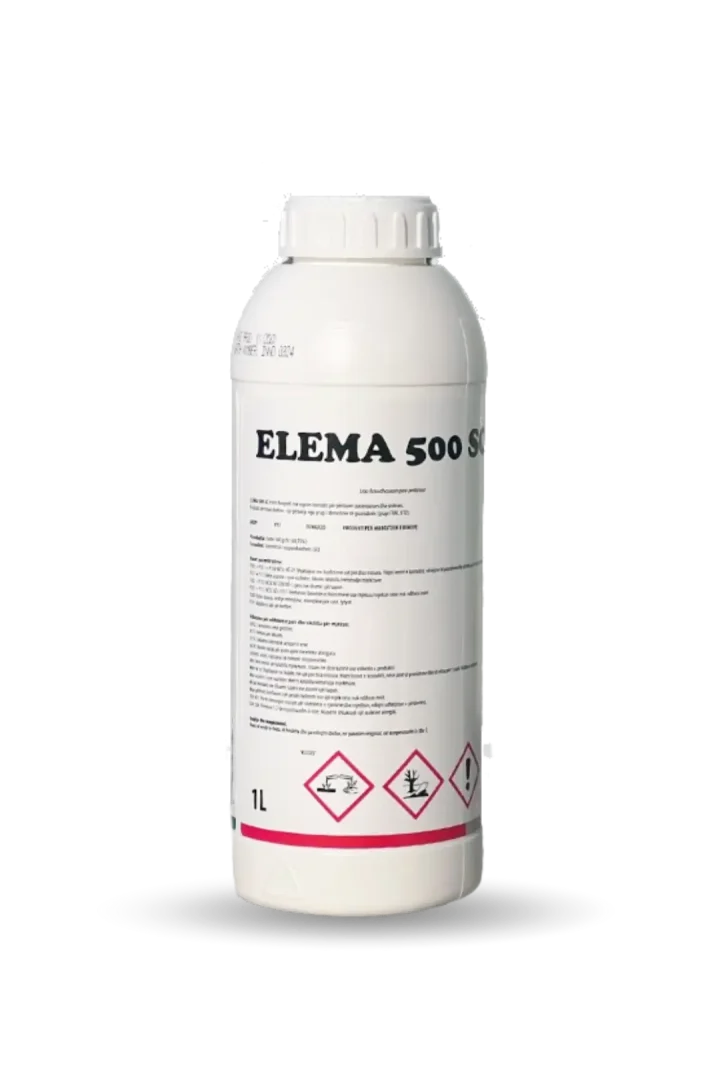
Agroblend ELEMA 500 SC Home Organic Protection Product Information on the product Type: A broad-spectrum contact fungicide for the control of fruit tree diseases, with both preventive and curative action. Active ingredient: Dodine 500 g/L (48.73%)Formulation: Suspension Concentrate (SC) Usage: Apples, peaches, cherries, olives Phytotoxicity: Not phytotoxic if used according to the label. Do not use the product during flowering. Pre-harvest interval (PHI): Apples – 60 days Please consult the technical service for advice on specific crops and conditions. Contact Now >> Agroblend Check out our product catalog! For a list of all the products & information on their usage. Click here to view >> Tap here to view >> Agroblend Other Products AZOPHOSKA 16-16-16+5S +TE Fontelis ULTRA DAP 20+20+0+14S+1 MGO+TE NU-SLOW – 28
Gure Kali 98-99%
Agroblend Gurë Kali 98-99% Home Fungicide Product Information on the product Active Ingredient: Copper sulfate 98-99% in crystalline form Can be used concentrated or mixed with lime in the form of Bordeaux paste. Usage:– Winter treatment for all crops– Fungicide for various fungal diseases– Can be used concentrated or mixed with lime– Very high solubility without residue Contact Now >> Agroblend Check out our product catalog! For a list of all the products & information on their usage. Click here to view >> Tap here to view >> Agroblend Other Products Alial 80 WP Olive Gold (22-6-12 +0.3 Bor) suluSOP 52% Take Up
Paste Bordoleze 20%
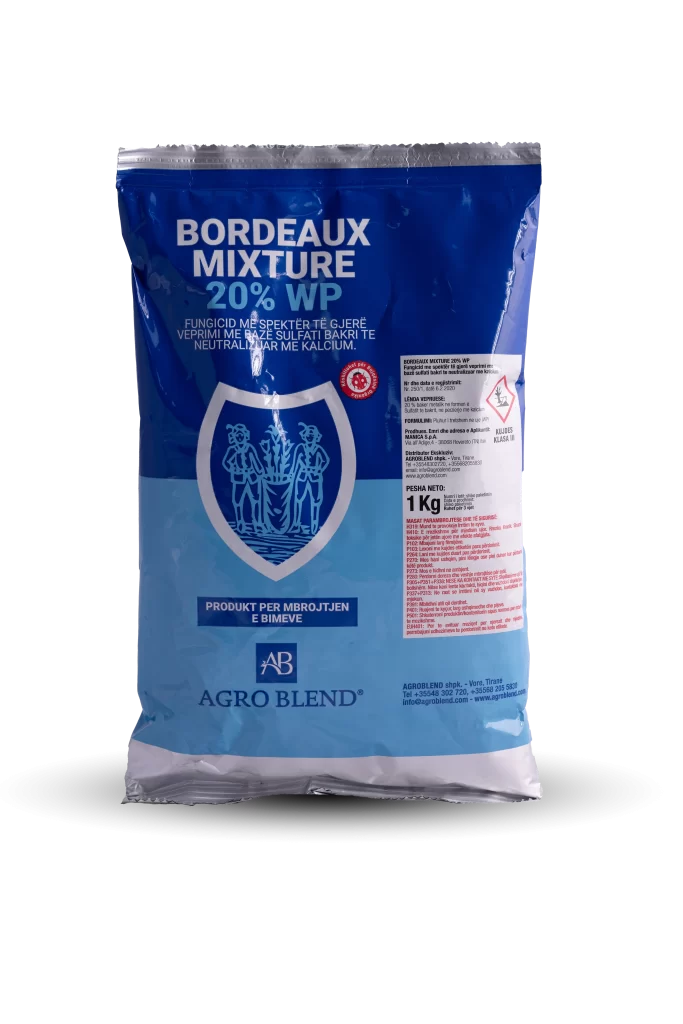
Agroblend Bordeaux Mixture 20% Home Fungicide Product Information on the product Weight: 1kgFormulation: Water-soluble powder (WP)Type: Contact fungicide with preventive and curative action Bordeaux mixture is a broad-spectrum contact fungicide used as a preventative against a wide range of fungal diseases sensitive to copper. Thanks to its special formulation and the perfect copper-calcium combination, the product is ideal for ensuring uniform coverage for the crops where it will be used. Please consult the technical service for advice on specific crops and conditions. Contact Now >> First aid instructions and medical advice: • H318: Causes serious eye damage. P305 + P351 + P338: IN CASE OF EYE CONTACT: rinse with plenty of water and soap for several minutes; remove contact lenses and rinse thoroughly. • In case of skin or mucous membrane contact: rinse with plenty of water and soap. • In case of inhalation of spray solution with respiratory organs: move the affected person to a warm and ventilated area. • P310: Seek immediate medical attention or go to an anti-poison center. THERAPY: Stomach lavage with milk and egg whites, and in cases of high copper levels, use gel-forming substances like penicillamine orally or CaEDTA and BAL intramuscularly. Information Additional Information PhytotoxicityDo not apply during blooming. This product may be phytotoxic to crops not mentioned on this label. On peach, apricot, and certain apple varieties (Abbondanza, Belfort, Black Stayman, Golden Delicious, Gravenstein, Jonathan, Rome Beauty, Morgenduft, Stayman, Stayman Red, Stayman Winesap, Black Davis, King David, Renetta del Canada, Rosa Mantovana) and pear varieties (Abate Fetel, Buona Luigia d’Avranches, Butirra Clairgeau, Passacrassana, B.C. William, Dott. Jules Guyot, Favorita di Clapp, Kaiser, Butirra Giffard), which are sensitive to copper, Bordeaux mixture can be phytotoxic if used during rapid vegetative growth. In such cases, non-use is recommended. Environmental Impact:H410: Very toxic with long-lasting effects on aquatic organisms.P273: Avoid release into the environment. Do not pollute waterways, ditches, or ponds with the spraying solution or packaging.P391: Collect spillage. Waiting Period (Pre-Harvest Interval):• 3 days for strawberries, potatoes, tomatoes, eggplants, root vegetables, bulb vegetables, cucurbits.• 7 days for leafy crops and fresh herbs.• 40 days for stone fruits.• 20 days for other crops. Storage:Store in the original containers in dry, ventilated areas at temperatures between 0°C and 35°C. Information Usage & Dosage Usage:Bordeaux mixture is a broad-spectrum contact fungicide used as a preventive measure against a wide range of fungal diseases sensitive to copper. Thanks to its special formulation and the perfect copper-calcium combination, the product ensures uniform coverage for crops where it will be applied. Solution Preparation:Dissolve the required amount of product in a small quantity of water, then pour it into the tank filled with the necessary amount of water, mixing continuously. The product is neutralized, and no lime should be used. Bordeaux mixture should be applied according to the calendar norms for control, with intervals of 7-12 days, depending on temperature and humidity conditions. During seasons with heavy rainfall, larger doses and shorter treatment intervals should be used.It is compatible with main antiparasitics, especially with sulfur formulations. Usage Notes & Compatibility:Treated seeds that have been in excess after sowing should not be used as food for humans or animals. Do not apply against the wind. In case of mixing with other formulations, the longest waiting period should be followed. Also, carefully observe the guidelines for products with higher toxicity. Please consult the technical service for additional advice on compatibility. CAUTION:It should be used only in agriculture; any other use may be dangerous. Following the instructions is essential to ensure treatment effectiveness and avoid damage to plants, humans, or animals. Information Precautionary Measures Precautionary Measures: • Keep in a safe place out of reach of children. • Store in a dry, cool place, away from food and beverages for humans, as well as animal feed. • Avoid prolonged contact of eyes and skin with the product. • Avoid inhalation of the product while preparing the spraying solution and during spraying. • Do not eat, drink water, or smoke during use. • P280: Wear gloves, appropriate work clothes, goggles, and a face mask. • After finishing the work, wash protective equipment and spraying tools. • After completing the task, wash hands and exposed body parts. • EUH401: To avoid risks to human health and the environment, follow the usage instructions. • P501: Dispose of containers in accordance with the current regulations. Information Active Ingredients Active Ingredients 20% metallic copper in the form of copper sulfate, blended with calcium Information Usage & Dosage Crop Parasites Time of Use Dosage Vine Downy mildew, anthracnose, black rot, secondary action against Botrytis – treatments before flowering – treatments after flowering – treatments for closure 600-700 g/hl 700-1000 g/hl 800-1000 g/hl Pome fruits (Apple, pear, fig) Scab, monilinia, septoria, branch canker, alternaria – treatments in autumn – treatments before flowering – treatments after flowering 800-1600 g/hl 700-1000 g/hl 800-1000 g/hl Olive Peacock eye, anthracnose, and other bacterial diseases Treatments at the end of winter 800-1200 g/hl Kiwi Neck rot 10-15 liters of solution based on the trunk 800-1200 g/hl Strawberries Powdery mildew, rot, anthracnose Vegetative start 500-1000 g/hl Rice Green algae As soon as the first signs appear 6-10 kg/ha Crop: Vine Parasites: Downy mildew, anthracnose, black rot, secondary action against Botrytis Time of Use: Treatments before flowering, after flowering, and for closure Dosage: 600-700 g/hl, 700-1000 g/hl, 800-1000 g/hl Crop: Pome fruits (Apple, pear, fig) Parasites: Scab, monilinia, septoria, branch canker, alternaria Time of Use: Treatments in autumn, before flowering, and after flowering Dosage: 800-1600 g/hl, 700-1000 g/hl, 800-1000 g/hl Crop: Olive Parasites: Peacock eye, anthracnose, and other bacterial diseases Time of Use: Treatments at the end of winter Dosage: 800-1200 g/hl Crop: Kiwi Parasites: Neck rot Time of Use: 10-15 liters of solution based on the trunk Dosage: 800-1200 g/hl Crop: Strawberries Parasites: Powdery mildew, rot, anthracnose Time of Use: Vegetative start Dosage: 500-1000 g/hl Crop: Rice Parasites: Green algae Time of Use: As soon as the first signs appear Dosage: 6-10 kg/ha Agroblend Check out
Sulfolac 80 WG
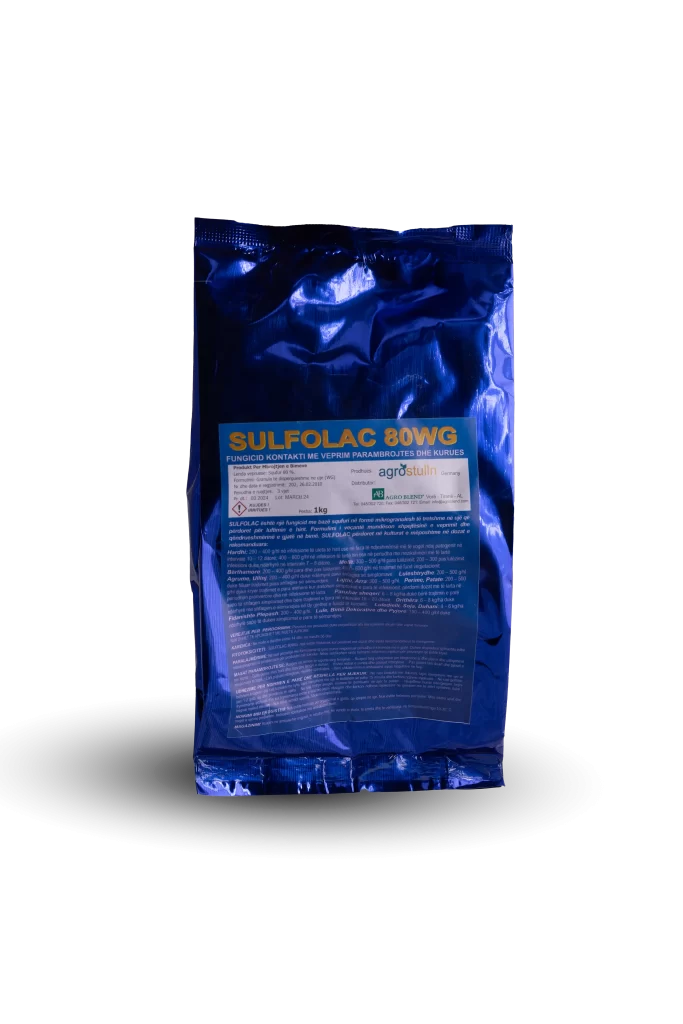
Agroblend Sulfolac 80 WG Home Fungicide Product Information on the product Weight: 1kgFormulation: Water-dispersible granules (WG).Appearance: Brown granules.Type: Contact fungicide with preventive and curative action SULFOLAC is a sulfur-based fungicide in the form of water-dispersible microgranules, used for fighting powdery mildew. The special formulation enables fast action and long-lasting stability on plants. Please consult the technical service for advice on specific crops and conditions. Contact Now >> First aid instructions and medical advice: • In case of skin contact, wash immediately with plenty of water and soap. • In case of eye contact, rinse immediately with plenty of water for at least 15 minutes and seek medical help. • In case of ingestion, drink 1-2 glasses of water and induce vomiting. • In case of inhalation of vapors, move the affected person to fresh air. • If unconscious, perform artificial respiration, and when breathing is difficult, administer oxygen and seek medical help at the nearest hospital, showing the doctor the label. • No specific antidote is known. Symptomatic treatment Information Additional Information Warnings for use:Mix with commonly used plant protection products, excluding those with alkaline reactions and mineral oils. Impact on the ecosystem:• Not harmful to aquatic organisms. Do not contaminate water bodies, watercourses, the spray solution, or empty packaging.• Not harmful to bees. Phytotoxicity:Not phytotoxic when used at the recommended doses and as per the instructions above. Withholding period:• For apples and pears: 14 days• For grapevines: 56 days. Storage:Keep in the original packaging, tightly closed, in dry, dark, and ventilated areas, at temperatures between 10-30°C. Information Usage & Dosage In grapevines: for control of powdery mildew (Uncinula necator), use 10 kg of product/ha, with up to three treatments. For control of escoreiosis, use 12.5 kg of product/ha. In cereals, for control of powdery mildew, use 10 kg of product/ha. In apples: for control of powdery mildew, use 1% before flowering, and 0.75% during and after flowering. Information Precautionary Measures • Keep out of reach of children. • Keep away from animal feed, beverages, and human food. • Do not eat, drink, or smoke while working. • Wear work clothes and protective equipment. • After work, wash hands and exposed parts of the body. • Clean protective equipment and spraying tools. • Dispose of packaging according to current regulations. Information Active Ingredients Active Ingredients Sulfur 80% Information Compatibility Mix with commonly used plant protection products, excluding those with alkaline reactions and mineral oils. Please consult the technical service for additional advice on compatibility. Agroblend Check out our product catalog! For a list of all the products & information on their usage. Click here to view >> Tap here to view >> Agroblend Other Products GARDENE Solar Micro Finisher 12-6-36 +TE Kalisop (50% K₂O + 44% SO₃) Entec Super® 13-10-20 +TE
Batalion 450SC
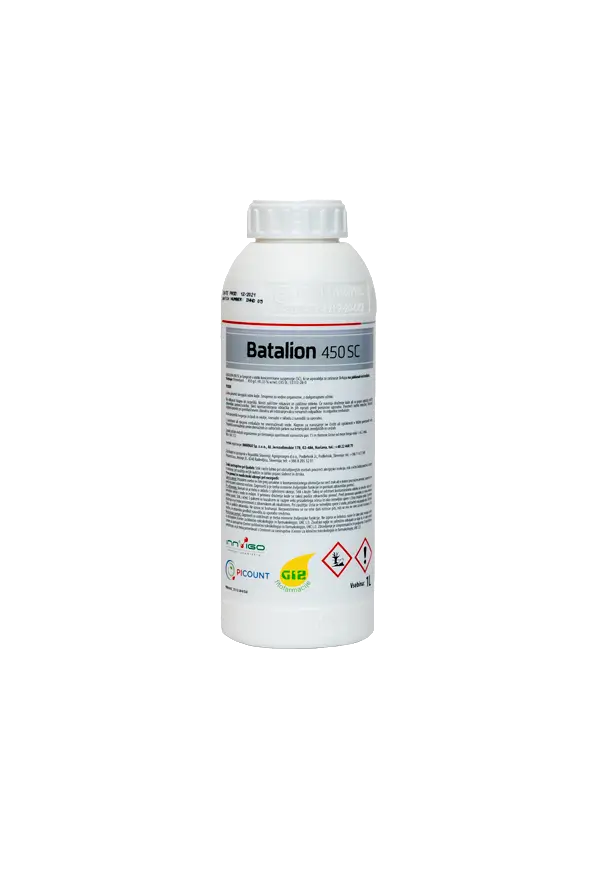
Agroblend Batalion 450SC Home Fungicide Product Information on the product Weight: 1LFormulation: Concentrated Suspension (SC)Type: Systemic fungicide with a broad spectrum of action. A systemic fungicide with a broad spectrum of action, for the control of diseases in fruit trees, vines, vegetables, and ornamental plants. It provides maximum protection against diseases, with various application methods, both preventive and curative. Please consult the technical service for advice on specific crops and conditions. Contact Now >> First aid instructions and medical advice:If you need medical advice, keep the container or label of the product on hand.In case of exposure or contact: Seek medical advice/attention. • General information: Poisoning symptoms may occur even after many hours; if symptoms appear, place the affected person under medical supervision. • In case of inhalation: Keep the person in clean air and call a doctor. If the affected person is unconscious, keep them or transport them in a side-lying position. • In case of skin contact: Wash hands thoroughly immediately with water and soap. If skin irritation persists, consult a doctor. • In case of eye contact: Rinse eyes by holding the eyelids open for several minutes with running water. Seek medical treatment. • In case of ingestion: Rinse the mouth. Do not induce vomiting; seek immediate medical help. • If necessary, show the doctor the packaging or label of the product. • No specific antidote known. Treat symptomatically. Information Additional Information Mode of Action:Batalion 450 SC is a fungicide in the form of a concentrate for preparing a water-based suspension with a surface effect, intended for preventive and curative use. PRECAUTIONARY MEASURES, WITHHOLDING PERIOD, AND SPECIAL CONDITIONS OF USE The period from the last application to harvest day (withholding period):• Apple, pear – 28 days.• Raspberry, strawberry – 3 days. It is recommended to use the agent alternately with fungicides from other chemical groups for a different mechanism of action. TO COMBAT THE FORMATION OF DISEASE RESISTANT STRAINSFungicides containing active substances from the anilinopyrimidine group (pyrimethanil, cyprodinil) should not be used more than 4 times during the growing season. PREPARATION OF THE SOLUTIONBefore preparing the solution, determine the required amount. Shake the contents of the package before use. Pour the measured amount of the agent into the partially filled sprayer tank (with the agitator running). Rinse the empty bottles three times with water and pour the rinsate into the sprayer tank along with the solution. Add water to the required amount. After pouring the product into the sprayer tank, which is not equipped with a hydraulic mixer, mix the liquid mechanically. TREATMENT OF RESIDUES AND CLEANING OF THE EQUIPMENTThe residues of the working solution after use should be treated in a manner that minimizes the risk of surface and groundwater contamination, in accordance with the provisions of the Water and Soil Pollution Law, i.e. • after dilution, it can be used on the treated area, if possible • or neutralized with the use of technical solutions ensuring the biological degradation of the product’s active substances • or disposed of in any other manner according to the provisions for waste disposal. Clean the equipment thoroughly after use.Use the same protective equipment when dealing with cleaning water for the equipment. Information Usage & Dosage Product for use with self-propelled sprayers or tractors. Apple– Venturia inaequalis.– Maximum dose for a single application: 1.0 l/ha.– Recommended dose for a single use: 0.7 – 1.0 l/ha.– Use the higher recommended doses in cases of greater disease risk.– Maximum number of treatments during the growing season: 3.– Minimum interval between treatments: at least 7 days.– Application time: Used from the visible flower bud stage to the end of the flowering phase (BBCH 55-69), preventively every 7-10 days depending on weather and signaling, or as intervention up to 72 hours after infection.– Recommended solution volume: 500 – 750 l/ha.– Recommended spraying: medium droplets. APPLICATION OF THE PRODUCT IN SMALL CROPS AND SMALL APPLICATIONSThe user is solely responsible for the effectiveness and phytotoxicity of the product used in small crops. Strawberry– Botrytis cinerea– Application time: Use the product from the beginning of the flowering phase to fruit maturation (BBCH 61-87).– Maximum recommended dose for a single use: 1.66 l/ha.– Maximum number of treatments during the growing season: 2.– Interval between treatments: at least 7 days.– Use the agent with a self-propelled garden sprayer or a tractor-type sprayer with a range of Fragaria or a fan sprayer with a directed airflow.– Recommended solution volume: 500-750 l/ha.– Recommended spraying: medium droplets. Raspberry– Botrytis cinerea, Didymella applanata– Application time: Use the product during the period of greatest disease risk when the fruit is in full bloom and after harvesting the fruit and pruning old shoots (BBCH 65-87).– Maximum recommended dose for a single use: 1.66 l/ha.– Maximum number of treatments during the growing season: 2.– Interval between treatments: at least 7 days.– Apply the agent using a fan sprayer with a directed airflow.– Recommended solution volume: 1000 l/ha.– Recommended spraying: fine droplets. Pear– Venturia pirina– Application time: Use the product from the visible flower bud phase to the end of the flowering phase (BBCH 55-69), preventively every 7 days depending on weather and signaling, or as intervention up to 72 hours after infection.– Maximum dose for a single use: 1.0 l/ha.– Recommended dose for a single use: 0.7 – 1.0 l/ha.– Use the higher recommended doses in cases of greater disease risk.– Maximum number of treatments during the growing season: 2.– Interval between treatments: at least 7 days.– Recommended solution volume: 500-750 l/ha.– Recommended spraying: medium droplets. Information Usage & Dosage CARE FOR WORKERS AND OTHERSBefore using the product, all interested parties who might be at risk from spray drift and who have requested such information should be informed.Eating, drinking, or smoking during product application is prohibited.Inhalation of the product should be avoided. Avoid skin contamination. • OPERATOR: Must wear protective gloves and protective clothing (including a hooded coverall) to protect against the effects of plant protection products, as well as appropriate footwear during the preparation
Galileo 125
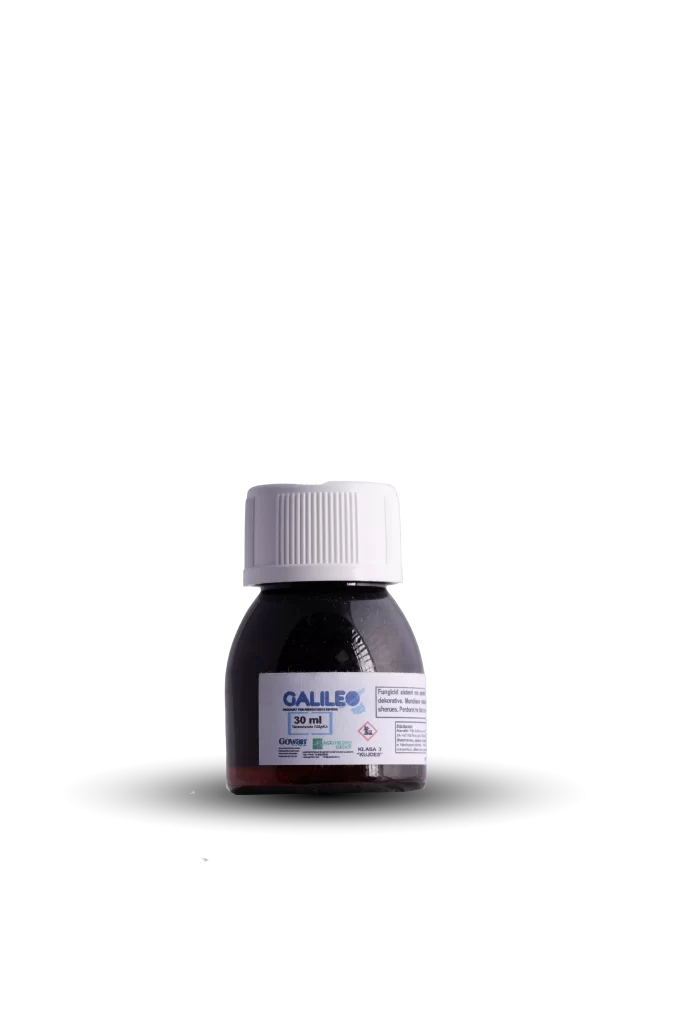
Agroblend Galileo 125 Home Fungicide Product Information on the product Formulation: Water emulsion (EW)Type: Systemic fungicide with a broad spectrum of action. GALILEO 125 EW is a systemic fungicide with a broad spectrum of action, used for controlling diseases in vineyards, fruit trees, vegetables, and ornamental plants. GALILEO 125 EW provides maximum protection against diseases, with different application methods, both preventive and curative. It is used in various vegetative phases, either alone or in combination with other products, depending on the appropriate treatment. Please consult the technical service for advice on specific crops and conditions. Contact Now >> First Aid Instructions and Medical Advice:First Aid Instructions and Advice for the Doctor: • H317: May cause an allergic skin reaction. • H361: Suspected of damaging fertility. • H373: May cause damage to organs through prolonged or repeated exposure. • EUH208: Contains spinetoram and 1.2-benzisothiazol-3(2H)-one. May cause an allergic reaction. • In case of inhalation: Move the person to fresh air. • In case of breathing cessation: Alert emergency services or an ambulance, then administer artificial respiration; to perform mouth-to-mouth respiration, the rescuer should use proper protection (e.g., a pocket mask). • In case of skin contact: Immediately remove contaminated clothing. Rinse immediately with plenty of water for 15-20 minutes. • In case of eye contact: Keep the eyes open and rinse slowly and gently with water for 15-20 minutes. • Remove contact lenses, if present, after the first 5 minutes and continue rinsing the eyes. • P101: If medical advice is needed, keep the container or product label nearby. • P308-P313: If exposed or concerned: Immediately call a poison center or a doctor. • No specific antidote. Symptomatic treatment. Information Additional Information Usage Warning:In areas with historically high infection levels, include the product in a specific pest control program. To reduce the likelihood of resistance phenomena, the product should be included in a strategy that alternates spinetoram-based and spinosad-based products with others that have different mechanisms of action. Do not perform more than two treatments per season. Strictly follow the dosages indicated on the label. Treat in the absence of wind. Phytotoxicity:When used alone, the product does not show phytotoxicity problems. Environmental Impact:– H410: Very toxic to aquatic life with long-lasting effects. Avoid contaminating water with the container or product. To protect aquatic organisms, do not use closer than 20 meters from water surfaces. Avoid cleaning equipment near water surfaces. – P273: Do not pollute the environment.– P391: Collect spillage.– P501: Dispose of the product/container in accordance with local regulations.– SP1: Do not contaminate water with the product or its container.– P501: Dispose of contents/container in accordance with legislation. Do not clean sprayers near surface waters. Avoid contamination via drainage systems. Withdrawal Period:– 3 days for citrus, cherries, and sour cherries.– 7 days for apples, pears, quinces, wild apples, medlar, peaches, nectarines, apricots, plums, figs, blueberries, persimmons, grapes, strawberries, and raspberries.– 14 days for pistachios.– 21 days for olives. Storage Conditions:Store the product in sealed containers, in dry and cool places. The storage temperature should not exceed 35°C. Do not store in direct sunlight or humidity. Information Usage & Dosage Usage:Delegate is based on spinetoram, an active ingredient derived from a bacterium (Saccharopolyspora spinosa) present in the soil and later chemically modified. It is used for controlling a wide range of pests that feed on leaves, including lepidopterans, thrips, leaf miners, and some psyllids that infest various crops. In apples, pears, quinces, medlar, persimmon, pomegranate, and figs: 2 treatments per season are allowed, with an interval of 7-14 days. Against Cydia pomonella, treat at egg hatching with 300-400 g/ha. Against Pandemis spp., Argyrotaenia pulchellana, Archips spp., Adoxophyes spp., treat when eggs hatch or against winter brood larvae with 300-400 g/ha. Against peach borer (Cydia molesta), treat near harvest time with 300-400 g/ha. Against Leucoptera scitella, Phyllonoricter spp., treat at the hatching of the first eggs with 350-400 g/ha. Against Psylla pyri, treat at the yellow egg stage with 400 g/ha. The product has a good effect against Cacopsylla melanoneura, which may be present when treating the main pests. In peaches, nectarines, apricots, plums, cherries, and sweet cherries: 2 treatments per season are allowed, with a 28-day interval. Against peach borer, Anarsia lineatella, and Cydia funebrana, treat at egg hatching with 300-400 g/ha. Against thrips (Thrips meridionalis, Thrips major, Frankliniella occidentalis), treat at the first appearance of the pest with 300-400 g/ha. Against Asian fruit fly (Drosophila suzukii), treat at the appearance of the pest with 300-400 g/ha. The product also has a good side effect against Ceratitis capitata. In olives: 2 treatments per season are allowed, with a 28-day interval. Against olive borer (Prays oleae) and (Philaenus spumarius), treat when the pest is present with 75 g/ha. In citrus: 2 treatments per season are allowed, with 300-400 g/ha, at a 7-14 day interval. Against psyllids, leaf miners, leaf curlers, and citrus thrips (Scirtothrips citri), use with 800 g/ha/season. Do not use in greenhouse citrus. In vineyards: 2 treatments per season are allowed. Against grapevine borer and thrips, treat at egg hatching with 250-300 g/ha. In pistachios: 1 treatment per season is allowed. Against Agonoscena sp., treat at the appearance of the pest with 100 g/ha. In strawberries, raspberries, blackberries, blueberries: 2 treatments per season are allowed. The doses refer to a solution of 1200-1500 liters/ha. Against Cydia pomonella, treat at egg hatching with 300-400 g/ha. Against Pandemis spp., Argyrotaenia pulchellana, Archips spp., Adoxophyes spp., treat when eggs hatch with 300-400 g/ha. Against peach borer, treat near harvest time with 300-400 g/ha. For all crops, use 1000-1500 liters of solution/ha. Information Preventive Measures • P102: Keep out of reach of children. • P103: Read the label before use. • P201: Obtain special instructions before use. • P202: Do not handle until all safety precautions have been read and understood. • P281: Use protective clothing. • P405: Store locked up. • EUH401: To avoid risks to human health and the environment, follow the instructions for use. Information Active Ingredients Active Ingredients Spinetoram
